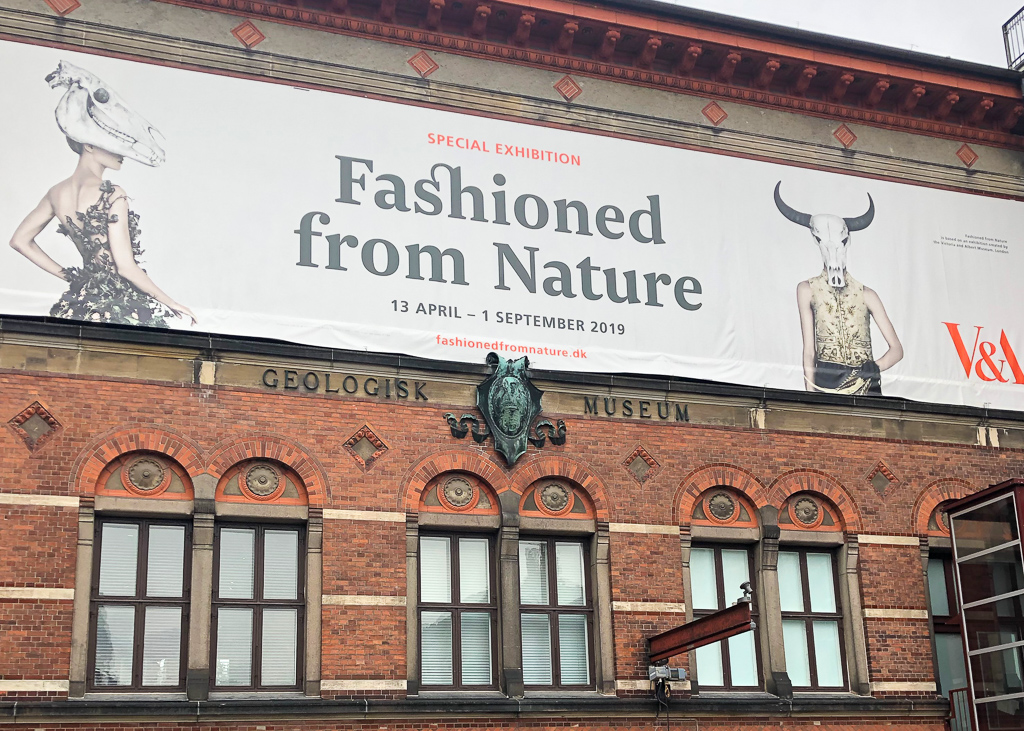I was enthralled by the Fashioned from Nature exhibit at the Victoria and Albert Museum when I saw it in London. In addition to the historical perspective of the textile industry, the theme of sustainability was evident throughout — an unexpected, but very pleasant surprise. So when I heard the exhibit was coming to Copenhagen where I live, I was as excited as if my favorite band was coming to town.
I set a date to visit, and invited my family and some close friends to join me. I wanted to share this incredible exhibit with everyone I knew. The experience in London had left such an impression on me, and I knew it would do the same for them.

“For a long time humans have used nature’s resources as if they are never ending, and our consumption has caused large areas of nature to become our trash can. Fashion has a special responsibility with its focus on fast change. Fashion has been driving consumption in a way that is out of balance with both nature and humans.

At the same time, fashion has a huge and dynamic potential. Just as fashion was part of enabling democracy by making goods available for all, fashion can also be a part in shaping our future vision for a culture of consumption in balance with nature.”
Else Skjold, Associate Professor
Fashion, Design and Sustainability, Kolding School of Design
More Than Just a Historical Perspective
The historical perspective I gained as I moved through both exhibits was a huge inspiration for the path I am on today. I appreciate an exhibit that helps us recognize our tiny, yet significant, role as consumers in a fast fashion culture.
This experience opened my eyes to the evolution of the textile industry, clearly laying out animal cruelty and environmental concerns that have been apparent throughout its history. The exhibit had a strong focus on how nature is playing a new role in fashion … not only in the design, as pictured below, but also in the materials we are engineering.



Modern-day fashion paying tribute to nature in less cruel ways than in the past.
And while this exhibit did a worthy job of shedding light on cruel animal practices that have since been abandoned, other aspects of the fashion industry were not covered. And this left me wondering if the industry has moved faster in treating animals better than the work being done to treat our human workforce better?


No animal was harmed making this dress. It is made entirely out of beads!
Fashioned from Nature, But with Labor Practices That Rival Slavery
When it comes to fashion industry practices today, the treatment of the labor force is still alarmingly sub par. From farming the natural resources, preparing the textiles and manufacturing the garments, this part of the labor force is drastically underpaid and the work conditions are horrifically unsafe.
History repeats itself, but it often does so in shocking and unexpected ways. In the case of fast fashion, we see blatant examples of a type of modern-day slavery. We should be more aware of and concerned with the fact that there does not appear to be enough change, and certainly nothing similar to the movements that led to the abolishment of slavery back in the 1800s.

“It is so important and timely that we now re-conceptualize what it means to wear and consume, and what is fashionable.”
Emma Watson, Foreword, Fashioned from Nature
Most hand-made (and homemade) garments were expensive to produce in the 1800s. As a result of the explosion of ready-to-wear fashions in the 1900s, we are now able to manufacture garments faster and sell them at a much lower retail price.
With the rapid production of fashion, we can also manufacture quantities of apparel that encourage a throw-away society. This not only encourages consumption, it also devalues the items being sold.
In the end, these items became worth less to us as consumers. But NOT worthless, as the cost was about to get so much higher, as this Patagonia ad so eloquently illustrates.
Could the future of fashion be leading us back to the beginning? A beginning where we buy less and appreciate more. A beginning where we value our clothes not only for the retail price we paid, but also for the labor that went into making them.

Are We too Caught up in Consumerism to Care?
Companies are continually trying to push more sustainable business practices. But is this taking us a step in the right direction, or just greenwashing?
Denmark’s Support of Ethical Fashion Industry Practices
Fashion exhibits are a rare occurrence in Denmark, which is what made the recent Fashioned from Nature exhibit in Copenhagen extra special for me. For an exhibit of this kind to make it here makes good sense. Denmark is known for its eco-conscious culture, as well as its simple, minimalistic and functional approach to design.
The country is also known for having been host to the Copenhagen Fashion Summit, the leading business event on sustainability in fashion, since its first summit in 2009. I believe exhibits like this, as small and limited in scope as they may seem, can help us all appreciate a garment for what it is worth, from its inception to its disintegration … that is, its true cost.

The True Cost
Protecting natural resources, abolishing animal cruelty, improving labor practices … when it comes to the fashion industry, where do we start?
Something I am struggling with every day.




what do you think?